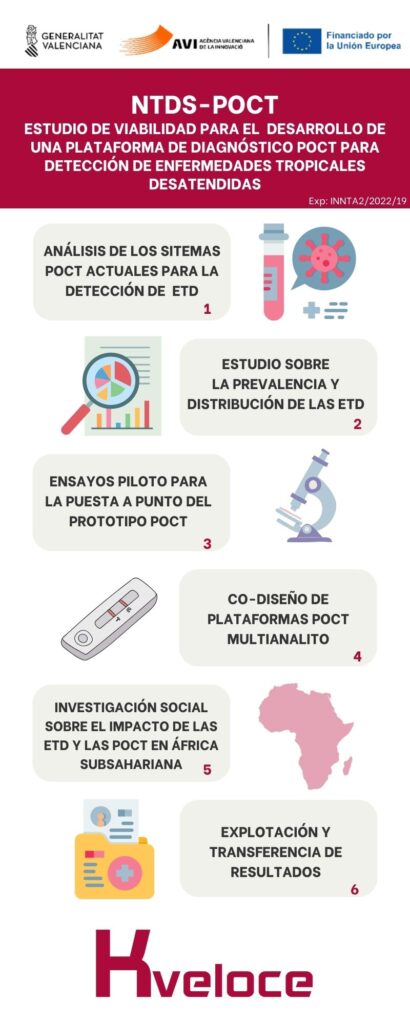Neglected Tropical Diseases (NTDs) represent a major global health challenge that deeply impacts the lives of over a billion people, primarily affecting vulnerable communities in tropical and subtropical regions.
Neglected Tropical Diseases (NTDs) are a group of 20 diseases* that affect over a billion people worldwide. They are caused by viruses, bacteria, parasites, fungi, and toxins, which are transmitted through contact with animals, contaminated food, unsafe water, or vectors (insects). NTDs represent a significant human, social, and economic burden, particularly in rural tropical and subtropical regions that are difficult to access. These areas are often characterized by poverty, unfavorable geographical conditions, and a high prevalence of potentially dangerous pathogens, which increase the incidence of NTDs. In Sub-Saharan Africa, limited access to quality diagnosis and medical care makes individuals in these communities vulnerable to NTDs.
NTDs are named due to the limited allocation of resources for their treatment and prevention, despite the focus on achieving global health coverage. January 30th is commemorated as World NTD Day, raising awareness about these diseases and encouraging investments in research, treatment, and prevention. Effectively addressing NTDs requires a range of multidisciplinary solutions. These include diagnosis, drug supply, vector control strategies, and improvements in sanitation and water treatment. The use of rapid diagnostic platforms at the point-of-care (POCT) is crucial in the fight against these pathologies, particularly in regions where access to specialized health centers is limited. These platforms offer an immediate and accessible solution for the early detection of these diseases, which is essential for effective treatment and prevention of their spread. The simplicity of use and ability to be implemented in basic infrastructure environments make them valuable tools for improving public health and reducing the burden of NTDs in vulnerable communities in Sub-Saharan Africa.
Since 2012, the World Health Organization (WHO) has significantly contributed to reducing the number of people requiring treatment for NTDs through the implementation of its roadmap. Thanks to international cooperation and sustained commitment, several countries have successfully eliminated at least one neglected tropical disease (NTD). The WHO has developed a new roadmap for 2021-2030 to further advance in the eradication and control of NTDs. This strategy aims to comprehensively address neglected tropical diseases (NTDs) in alignment with Goal 3 of the Sustainable Development Goals. Goal 3 seeks to “ensure healthy lives and promote well-being for all at all ages”. Specifically, the strategy focuses on achieving target 3.3, which aims to “end epidemics such as AIDS, tuberculosis, malaria, and NTDs by 2030, as well as combat hepatitis, waterborne diseases, and other communicable diseases”.
To contribute to the fight against NTDs, in line with the WHO’s roadmap and the SDGs, from KVELOCE we are implementing an R&D line focused NTDs on diagnostic points. Currently, we are carrying out the NTDs-POCT (INNTA2/2022/19) project, which is funded by the Valencia Innovation Agency and the European Union through the ERDF (European Regional Development Fund). The aim of this project is to conduct a feasibility study for the development of a POCT diagnostic platform that specifically targets NTDs in Sub-Saharan Africa. The research includes a comprehensive analysis of current diagnostic tools, molecular mechanisms, and existing POCT systems. We are designing POCT prototypes for detecting multiple neglected tropical diseases (NTDs), prioritizing diseases with specific treatments that are considered a priority by the WHO for diagnosis via POCT. Currently, we are conducting pilot trials with selected prototypes to validate their efficacy and reliability. Our research also includes cross-sectional aspects of the co-design and co-development process of accessible diagnostic platforms. This involves studying the communication and empowerment of local communities, as well as researching the social impact of NTDs and POCTs in the Sub-Saharan Africa region.This comprehensive approach aims not only to develop efficient diagnostic tools, but also to ensure their acceptance and effective use within the affected communities.

*NTDs include: Buruli ulcer; Chagas disease; dengue and chikungunya; dracunculiasis; echinococcosis; foodborne trematodiases; human African trypanosomiasis; leishmaniasis; leprosy; lymphatic filariasis; mycetoma, chromoblastomycosis, and other deep mycoses; noma; onchocerciasis; rabies; scabies and other ectoparasitoses; schistosomiasis; soil-transmitted helminthiasis; snakebite envenoming; taeniasis/cysticercosis; trachoma; and yaws
#beatNTDs #WorldNTDDay






